Monkeys are Made of Mangoes
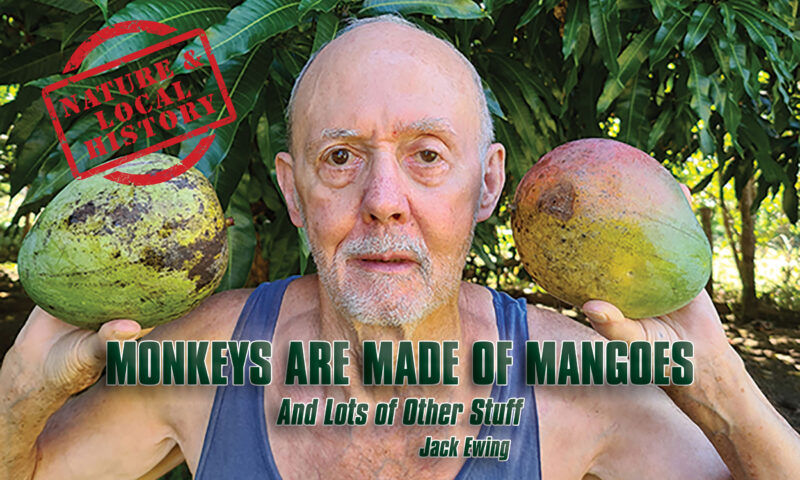
Hacienda Barú, where I live, was roughly half rainforest and half cattle pasture when we first moved here in the early 1970s. Today it is much different, mostly rainforest and is a well-known destination for ecological tourists and biological researchers. Living with the transformation of the land from cattle ranch to nature reserve has given me a wealth fascinating experiences, one of which I will share with you here.
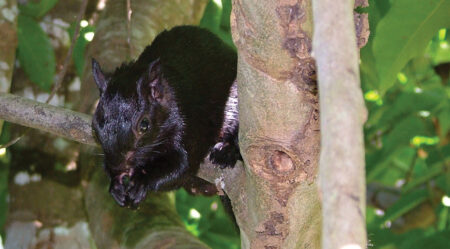 In 1979 we planted about 10 hectares of cacao, the stuff chocolate is made with. The uphill side of the plantation was adjacent to a rainforest and the lowland side bordered pasture and rice fields. After six years just when the plantation reached full production, the price of cacao plummeted to the point that cacao beans cost more to harvest than they were worth on the open market. We abandoned the cacao and the white-faced capuchin monkeys from the rainforest moved in and added cacao to their already hodgepodge of a diet. They don’t eat the cacao seeds, only the sweet-and-sour tasting syrup that coats them. That story is told in my first book, Monkeys Are Made of Chocolate.
In 1979 we planted about 10 hectares of cacao, the stuff chocolate is made with. The uphill side of the plantation was adjacent to a rainforest and the lowland side bordered pasture and rice fields. After six years just when the plantation reached full production, the price of cacao plummeted to the point that cacao beans cost more to harvest than they were worth on the open market. We abandoned the cacao and the white-faced capuchin monkeys from the rainforest moved in and added cacao to their already hodgepodge of a diet. They don’t eat the cacao seeds, only the sweet-and-sour tasting syrup that coats them. That story is told in my first book, Monkeys Are Made of Chocolate.
Prior to the arrival of the monkeys, variegated squirrels were the only wild animals that ate our cacao. They didn’t eat much, so we didn’t worry about them. When the monkeys began frequenting the plantations on a regular basis, the squirrels disappeared. We could see them at the ecolodge and in an area that was planted with teak trees, but they were absent from the cacao plantations and forested areas.
Beginning in 1987 Hacienda Barú started offering ecological hikes with me as the only guide at first and later, as demand grew, we hired more guides. None of us were biologists, but I had lived near the rainforest for 20 years, and all the others had practically grown up in the jungle. We all studied a lot so that we would be able to answer visitors’ questions. One of the guides learned that capuchin monkeys eat baby white-nosed coatis. They don’t mess with the adults, but raid the nests in the tops of rainforest trees, and eat the tiny helpless infants. Squirrel nests are similar to those of coatis and baby squirrels are even more helpless than baby coatis, so we assumed that they ate baby squirrels too. We later learned that the monkeys would also chase the squirrels and knock them to the ground, but that unless the monkeys were incredibly lucky it was pretty hard to kill and eat an adult variegated squirrel. Those nutcracking incisors are sharp. All of the squirrels moved out of the cacao and lived only in places where monkeys were absent. We later learned that capuchin monkeys eat iguanas or just about anything else they can catch and kill.
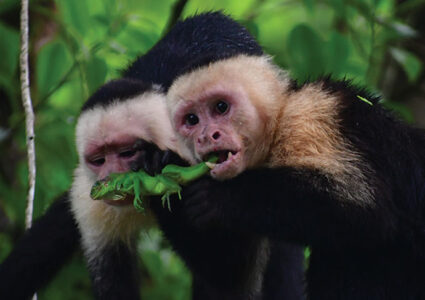 Hacienda Barú Lodge is bordered by cacao on one side and secondary forest on two. These are all places where monkeys are frequently seen. On the fourth side is a narrow access road to Barú Beach. Across that road is a former rice field that, in the mid-1980s was slated for development at some time in the indefinite future. We divided it into 24 lots with teak trees on half of each lot and mango and citrus trees on the other half. We figured that the lots could be marketed in 20 to 30 years, once there was decent access and infrastructure into the area. We figured they would be attractive to prospective buyers because the teak could be harvested for construction of a home and there would be producing fruit trees near the home. Monkeys weren’t interested in the area because it was on the other side of the beach road, which bordered 30 meters of pasture and teak trees.
Hacienda Barú Lodge is bordered by cacao on one side and secondary forest on two. These are all places where monkeys are frequently seen. On the fourth side is a narrow access road to Barú Beach. Across that road is a former rice field that, in the mid-1980s was slated for development at some time in the indefinite future. We divided it into 24 lots with teak trees on half of each lot and mango and citrus trees on the other half. We figured that the lots could be marketed in 20 to 30 years, once there was decent access and infrastructure into the area. We figured they would be attractive to prospective buyers because the teak could be harvested for construction of a home and there would be producing fruit trees near the home. Monkeys weren’t interested in the area because it was on the other side of the beach road, which bordered 30 meters of pasture and teak trees.
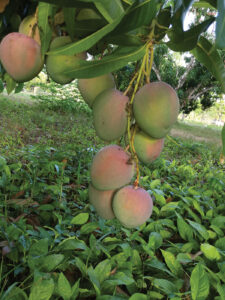 Things don’t always work out as planned. Today, 35 years later, none of the lots have been sold and no houses have been built, 90% of the teak has been cut for lumber, a variety of native trees have been planted where the teak used to be, the mango trees are big and beautiful and produce loads of mangoes. In 2018, we strung a thick rope bridge over the road to the beach so the monkeys could access a couple of mango trees, and on occasion I saw them come to the ground and run across a 20-meter gap to get to a third mango tree. They became very fond of mangoes.
Things don’t always work out as planned. Today, 35 years later, none of the lots have been sold and no houses have been built, 90% of the teak has been cut for lumber, a variety of native trees have been planted where the teak used to be, the mango trees are big and beautiful and produce loads of mangoes. In 2018, we strung a thick rope bridge over the road to the beach so the monkeys could access a couple of mango trees, and on occasion I saw them come to the ground and run across a 20-meter gap to get to a third mango tree. They became very fond of mangoes.
All this time the native trees planted within the former teak plantation were getting bigger and bigger. One day in 2021 during mango season I went on a late afternoon hike to get some exercise and, at the same time, see if I could find a couple of mangoes. But I found something even more exciting. A troop of about a dozen monkeys were playing around in a couple of the native trees which were mixed in with the few teak trees that hadn’t yet been cut. For me, seeing the monkeys in that location for the first time was a special treat.
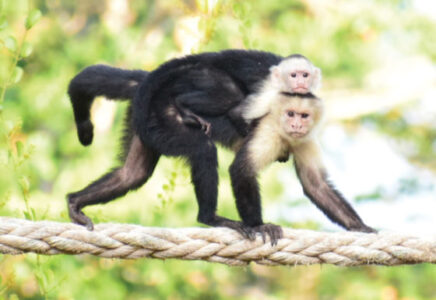 Three days later I went on another late afternoon mango-picking hike and decided to go to a tree I had seen recently that was replete with nearly ripe fruit. It was a good walk to get there and I could walk home along the edge of the old teak plantation and hopefully see some monkeys. I was in for a big surprise. The mango tree was full of monkeys who were picking mangoes like crazy. They took one or two bites out of each one and then threw it on the ground. I stood there watching for a minute before walking under the tree to try and salvage a mango or two. The monkeys got furious, screaming and throwing mangoes at me. They were so intent on driving me away from their tree that they didn’t bother to bite into the mangoes before throwing them, and I was able to grab a couple of whole, unbitten ones and escape the bombardment with nothing worse than a bruise on my left arm. I went home grinning from ear to ear with a beautiful, ripe mango in each hand. When I showed Diane and told her about the bombardment, she laughed and said, “There you go. Another book, Monkeys Are Made of Mangoes. If that idea ever becomes a reality, this article will be the first chapter.
Three days later I went on another late afternoon mango-picking hike and decided to go to a tree I had seen recently that was replete with nearly ripe fruit. It was a good walk to get there and I could walk home along the edge of the old teak plantation and hopefully see some monkeys. I was in for a big surprise. The mango tree was full of monkeys who were picking mangoes like crazy. They took one or two bites out of each one and then threw it on the ground. I stood there watching for a minute before walking under the tree to try and salvage a mango or two. The monkeys got furious, screaming and throwing mangoes at me. They were so intent on driving me away from their tree that they didn’t bother to bite into the mangoes before throwing them, and I was able to grab a couple of whole, unbitten ones and escape the bombardment with nothing worse than a bruise on my left arm. I went home grinning from ear to ear with a beautiful, ripe mango in each hand. When I showed Diane and told her about the bombardment, she laughed and said, “There you go. Another book, Monkeys Are Made of Mangoes. If that idea ever becomes a reality, this article will be the first chapter.

